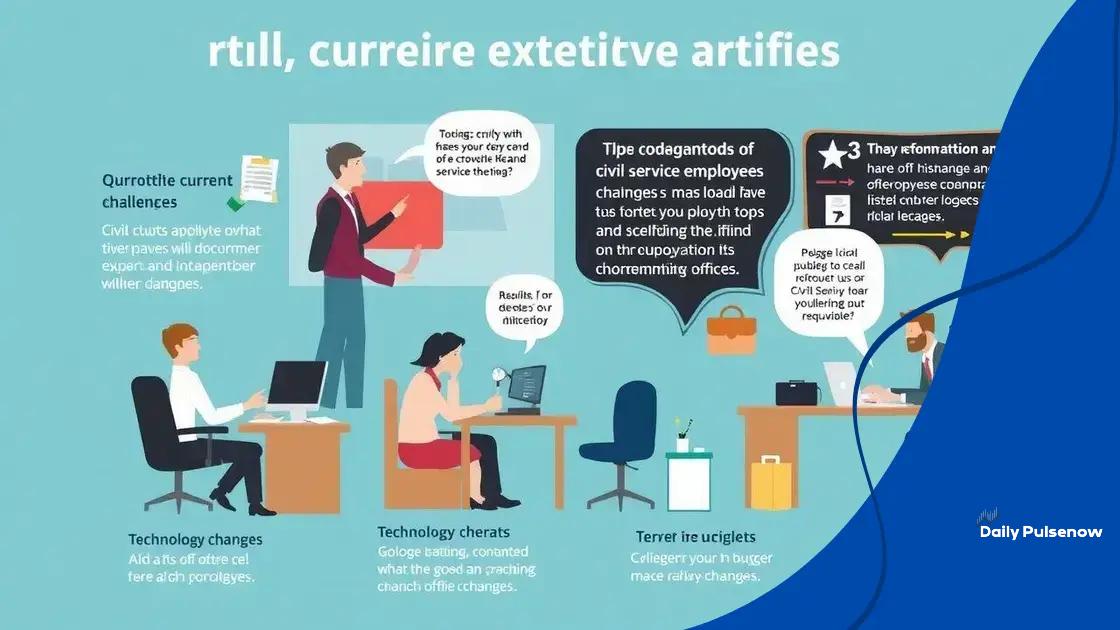Civil service protections debate: what’s at stake?

Anúncios
Civil service protections ensure fair treatment for government employees, safeguarding them from unjust dismissal and promoting accountability and efficiency in public service.
The civil service protections debate plays a crucial role in shaping how government agencies operate. Many wonder how these protections affect efficiency and employee rights, and the conversation continues to evolve. Let’s dive into the main issues surrounding this important topic.
Anúncios
Understanding civil service protections
Understanding civil service protections is crucial for grasping how public agencies function. These protections safeguard government employees against unjust dismissal and ensure fair treatment in the workplace. By knowing how these protections work, we can appreciate their impact on government efficiency and employee rights.
The Purpose of Civil Service Protections
The primary aim of civil service protections is to create a stable, effective workforce within government roles. This means preventing personal biases from interfering in hiring and firing practices. Without these protections, public servants could face arbitrary treatment based on politics or personal relationships.
Benefits of Civil Service Protections
- Enhances job security for employees
- Promotes accountability within government
- Encourages fair treatment of all workers
- Ensures that policies focus on qualifications and performances
These protections also boost morale among employees. When workers feel secure in their positions, they are more likely to innovate and connect with the public they serve. Thus, civil service protections highlight the balance between employee rights and public interest.
Anúncios
Another aspect to consider is the role of evaluations. Regular performance reviews help maintain standards and ensure accountability for employees. By focusing on objective evaluations rather than subjective opinions, civil service protections contribute to an efficient public sector.
In the end, understanding these protections reveals much about our government. They play a pivotal role in maintaining a competent workforce while safeguarding the rights of those who serve the public. Knowing their significance helps us navigate the ongoing debates around reforms and improvements in the civil service system.
Historical context of civil service reforms
The historical context of civil service reforms sheds light on how the public sector has evolved over time. These reforms were introduced to make the government more efficient and less influenced by politics. Understanding the changes that occurred helps us appreciate the current system.
Early Developments and Reforms
In the late 19th century, the Pendleton Act marked a significant shift. It aimed to eliminate the patronage system, which favored appointments based on political connections rather than merit. Instead, hiring and promotions started to depend more on examinations and qualifications.
Key Benefits of Reforms
- Reduced corruption in hiring practices
- Established a more professional workforce
- Increased accountability and transparency
- Promoted fairness and equal opportunity
These reforms laid the groundwork for the modern civil service. By creating a more equitable and skilled workforce, they shifted how government employees performed their duties. The reforms paved the way for future changes, focusing on enhancing effectiveness in public service.
Throughout the 20th century, various movements aimed to expand these protections. New laws emerged to address specific issues, such as gender and racial discrimination. As society changed, so too did the expectations for government employees.
The development of civil service protections continued through the decades, responding to public needs. The reforms aimed to provide stability within government roles while ensuring that workers had the protections necessary to do their jobs fairly. Today’s debates reflect this ongoing effort to balance efficiency with employee rights.
Current challenges in civil service protections

Understanding the current challenges in civil service protections is crucial for evaluating the effectiveness of these safeguards today. As society evolves, so do the issues that public employees face. This ensures that the protections meant to help them are continuously reassessed.
Budget Cuts and Resource Limitations
One major challenge is the impact of budget cuts on government agencies. With limited resources, agencies may struggle to maintain fair hiring and promotion practices. This sometimes leads to higher workloads and can compromise employee morale.
Political Influence and Changes
Political shifts can also influence civil service protections. Changes in leadership may bring new policies that weaken existing protections. Employees might feel insecure in their jobs, afraid that their positions could be threatened by political agendas.
Technological Advancements
Another challenge arises from technological advancements. Automation and digital processes can make job roles less secure, creating uncertainty about the future of many positions. Workers may worry their skills are becoming obsolete.
- The rise of artificial intelligence in government
- Shifts in job roles due to automation
- Need for retraining and upskilling
- Concerns about job security in a changing landscape
Additionally, the rise of remote work has prompted discussions about worker protections. Employees now face different challenges, such as flexibility vs. expectations for availability, which can lead to burnout. Striking a balance enhances productivity but poses potential risks to job satisfaction.
Understanding these challenges helps highlight the need for ongoing dialogue about civil service protections. As governmental structures adapt to contemporary issues, so too must the frameworks that protect employees.
The impact of reforms on public service
The impact of reforms on public service has been significant. These changes aim to enhance efficiency, transparency, and accountability in government operations. By understanding the effects of these reforms, we can better appreciate the current landscape of public service.
Improved Efficiency
One of the main outcomes of civil service reforms is improved efficiency. Streamlined processes lead to faster decision-making and implementation of policies. With clearer guidelines, employees can focus on their responsibilities without unnecessary delays.
Increased Accountability and Trust
Reforms also enhance accountability in public service. By establishing measurable performance standards, agencies can track progress and evaluate employee effectiveness. This fosters a culture of responsibility and can improve public trust in government institutions.
Challenges of Implementing Reforms
However, challenges exist. Implementing new systems can lead to resistance from employees who are accustomed to traditional methods. Some may fear job security or the ability to maintain quality under new pressures.
- Employee training and adaptation are crucial
- Communication about reforms helps ease transitions
- Monitoring outcomes ensures the success of reforms
- Engaging employees in the reform process can lead to better results
Despite these challenges, the overall goal remains clear: to create a more effective and responsive public service. Continuous evaluation and adjustment of practices can lead to sustainable improvements over time.
Future reforms will likely focus on technology integration and enhancing citizen engagement. As trends change, public services must adapt to meet new expectations and needs. This ongoing evolution benefits both employees and the community they serve.
Possible solutions and future directions
Exploring possible solutions and future directions for civil service protections is essential. As challenges arise, innovative approaches can enhance the effectiveness of these systems. Evaluating new ideas helps to create a resilient public service.
Strengthening Training Programs
One potential solution involves strengthening training programs for government employees. By focusing on continuous professional development, employees can adapt to changes and improve their skills. This enhances their performance and increases job satisfaction.
Utilizing Technology
Another exciting direction is the use of technology to streamline processes. Embracing tools like digital platforms for applications and evaluations can make operations faster and more efficient. Engaging employees with user-friendly systems also fosters transparency.
- Implementing e-learning resources
- Developing mobile applications for team communication
- Utilizing data analytics for performance tracking
- Encouraging feedback through online surveys
Additionally, it’s vital to encourage open communication between management and employees. Establishing forums for dialogue helps address concerns and fosters a sense of belonging. Such practices contribute to strong morale and better workplace engagement.
Considering the future, reforms should focus on flexibility. This will accommodate the unique needs of various departments and employees, leading to a more adaptable workforce. Tailoring solutions ensures that protections remain relevant in a rapidly changing environment.
Overall, moving forward requires a balanced approach. Combining innovative practices with the core values of public service will enhance effectiveness. By pursuing these solutions, we can build sturdier civil service protections and foster a healthier workplace.
FAQ – Frequently Asked Questions about Civil Service Protections
What are civil service protections?
Civil service protections are laws and regulations that ensure fair treatment for government employees, protecting them from unfair dismissal and discrimination.
Why are civil service protections important?
These protections help maintain a professional and stable workforce, ensuring that public employees are treated fairly and equitably.
What challenges do civil service protections currently face?
Current challenges include budget cuts, political influence, rapid technological advancements, and the need for open communication between management and employees.
How can future reforms strengthen civil service protections?
Future reforms can include improving training programs, utilizing technology, fostering open dialogue, and ensuring flexibility to meet evolving needs.